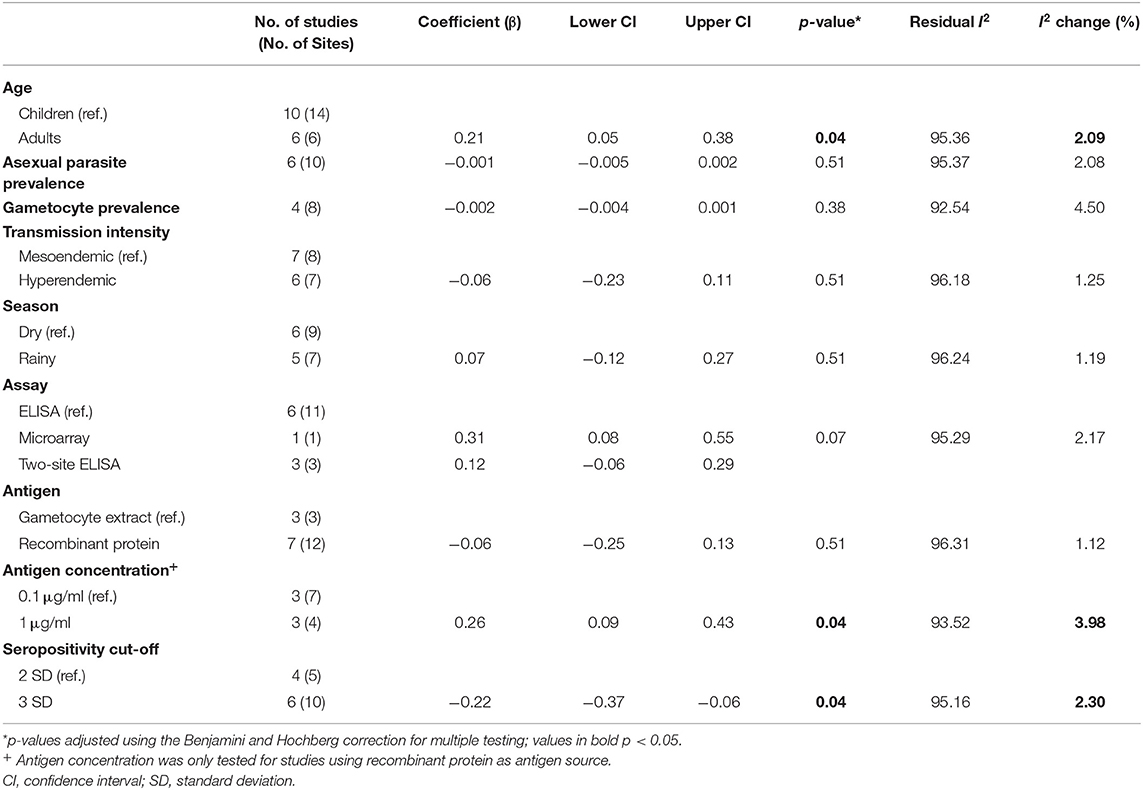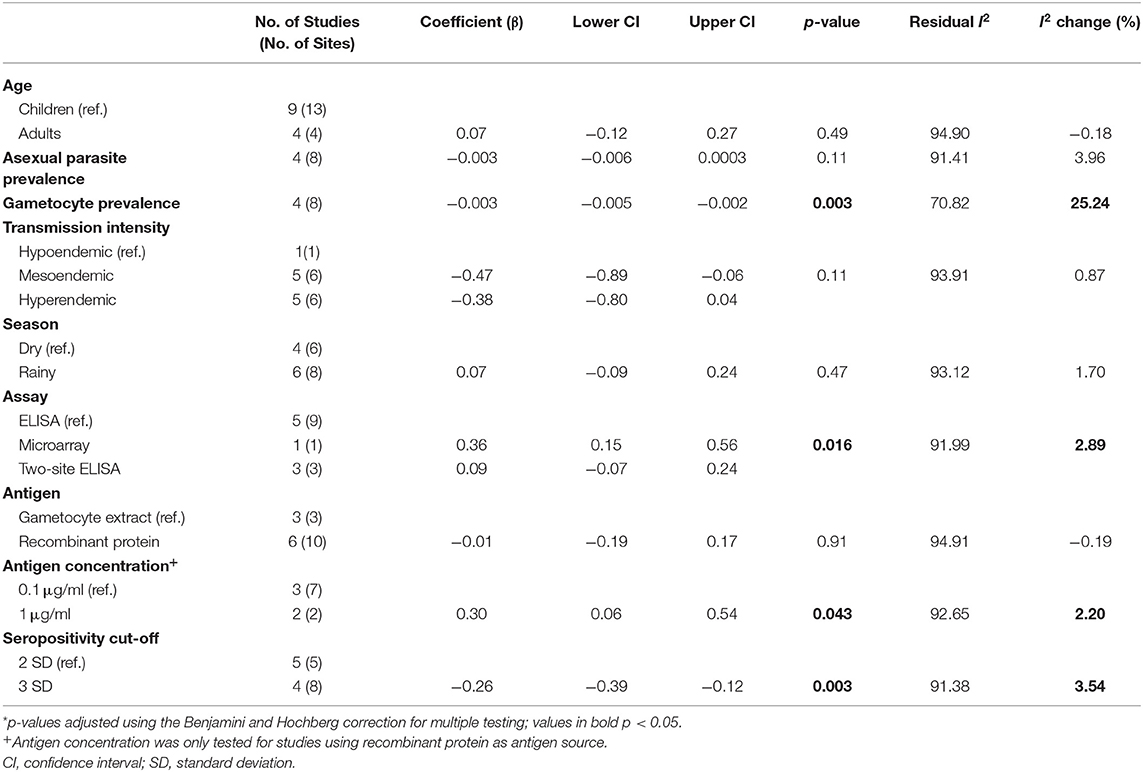
94% of researchers rate our articles as excellent or good
Learn more about the work of our research integrity team to safeguard the quality of each article we publish.
Find out more
CORRECTION article
Front. Immunol. , 23 March 2020
Sec. Microbial Immunology
Volume 11 - 2020 | https://doi.org/10.3389/fimmu.2020.00389
This article is part of the Research Topic Regulation of Immunity to Parasitic Infections Endemic to Africa View all 17 articles
This article is a correction to:
Immune Responses to Gametocyte Antigens in a Malaria Endemic Population—The African falciparum Context: A Systematic Review and Meta-Analysis
 Michelle K. Muthui1*
Michelle K. Muthui1* Alice Kamau1
Alice Kamau1 Teun Bousema2,3
Teun Bousema2,3 Andrew M. Blagborough4,5
Andrew M. Blagborough4,5 Philip Bejon1,6
Philip Bejon1,6 Melissa C. Kapulu1,6
Melissa C. Kapulu1,6A Corrigendum on
Immune Responses to Gametocyte Antigens in a Malaria Endemic Population—The African falciparum Context: A Systematic Review and Meta-Analysis
by Muthui, M. K., Kamau, A., Bousema, T., Blagborough, A. M., Bejon, P., and Kapulu, M. C. (2019). Front. Immunol. 10:2480. doi: 10.3389/fimmu.2019.02480
In the original article, there were errors in Tables 1, 2 and 3, and to the text. In Table 1, one of the two study sites from Amoah et al.'s study (Parasites & Vectors, 2018) was erroneously excluded from the table hence the study was presented as one site, the age range of study participants from the Stone et al. (Nature Communications, 2018) study site “Hauts-Bassins (Burkina Faso)” was mistakenly indicated as “2–74” instead of “5–14” years and the reference for Skinner et al. given as “35” instead of “33”. These errors have been corrected and the amended table appears in this article.

Table 2. Univariable meta-regression analysis of factors influencing reported seroprevalence to Pfs230.

Table 3. Univariable meta-regression analysis of factors influencing reported seroprevalence to Pfs48/45.
Furthermore, owing to the omission of the study site from Amoah et al.'s study, the figures quoted in the text on the overall number of study sites and the total number of study sites reporting seroprevalence to Pfs230 and Pfs48/45 were incorrect. The total number of study sites for Pfs230 was given as “14” instead of “15” and for Pfs48/45 given as “14” instead of “13”. Also, we inadvertently provided the total number of individual study locations (“23”) instead of the study sites—based on administrative region—(“17”) when providing a summary of the 12 studies that we included in the analysis. In addition, the citation for “Amoah et al.” was was incorrectly cited as “Acquah et al.” in the Results section, sub-section Pfs230, Seroprevalence, Paragraph 1.
These errors have been corrected and amendments made to the relevant result sections, given below.
Results section, sub-section Study Selection and Characteristics, Paragraph 1:
“The 12 studies were carried out across 17 study sites, majority of which were in West Africa (Burkina Faso, Senegal, Gabon, Cameroon, Ghana, and Mali) with only one study site in East Africa (Tanzania) and two study sites in Southern Africa (Zimbabwe) (Table 1). Ten articles (from 15 study sites) measured responses to Pfs230 and nine articles (13 study sites) measured responses to Pfs48/45. Six studies were longitudinal studies spread over the malaria transmission season with all but one measuring responses to both Pfs230 and Pfs48/45. Studies predominantly used ELISA as the immunoassay with only one study measuring responses using protein microarrays.”
Results section, sub-section Pfs230, Seroprevalence, Paragraph 1:
“Ten studies from across 15 study sites in Africa analyzed immune responses to Pfs230. The range of seroprevalence estimates was quite wide, ranging from 6% reported by Stone et al. in Soumousso and Dande villages, Burkina Faso (20) to 72% reported by Amoah et al. (34) (Figure 2). Significant heterogeneity was observed between the studies (I2 = 97%; 95% CI: 96–98%; p < 0.01) therefore, a pooled prevalence estimate was not calculated.”
Results section, sub-section Pfs48/45, Seroprevalence, Paragraph 1:
“A total of 9 studies carried out over 13 study sites measured immune responses to Pfs48/45. The range of seroprevalence estimates reported was 0% from Stone et al.'s study sites in Burkina Faso (20) to 64% reported by Paul et al. from their study in the Makoni district in Zimbabwe (43). As with Pfs230, there was significant heterogeneity between the studies, I2 =96% (95% CI: 95–97%), and hence no pooled estimate was calculated (Figure 3).”
Additionally, there were errors in Table 2 and Table 3, regarding the values for the No. of Studies (No. of Sites) under the variable Antigen. For Table 2, the numbers were switched around for gametocyte extract and recombinant protein and hence the numbers for Gametocyte extract read “7 (12)” instead of “3 (3)” and under the variable Recombinant protein read “3 (3)” instead of “7 (12).” For Table 3 one study was missing from the count hence the value for the No. of Studies (No. of Sites) under the variable Recombinant protein read “5 (10)” instead of “6 (10).” The corrected Tables 2 and 3 appear in this article.
The authors apologize for these errors and state that this does not change the scientific conclusions of the article in any way. The original article has been updated.
Keywords: immunity, Plasmodium falciparum, gametocytes, Pfs230, Pfs48/45
Citation: Muthui MK, Kamau A, Bousema T, Blagborough AM, Bejon P and Kapulu MC (2020) Corrigendum: Immune Responses to Gametocyte Antigens in a Malaria Endemic Population—The African falciparum Context: A Systematic Review and Meta-Analysis. Front. Immunol. 11:389. doi: 10.3389/fimmu.2020.00389
Received: 15 January 2020; Accepted: 19 February 2020;
Published: 23 March 2020.
Edited and reviewed by: Ian Marriott, University of North Carolina at Charlotte, United States
Copyright © 2020 Muthui, Kamau, Bousema, Blagborough, Bejon and Kapulu. This is an open-access article distributed under the terms of the Creative Commons Attribution License (CC BY). The use, distribution or reproduction in other forums is permitted, provided the original author(s) and the copyright owner(s) are credited and that the original publication in this journal is cited, in accordance with accepted academic practice. No use, distribution or reproduction is permitted which does not comply with these terms.
*Correspondence: Michelle K. Muthui, bW11dGh1aUBrZW1yaS13ZWxsY29tZS5vcmc=
Disclaimer: All claims expressed in this article are solely those of the authors and do not necessarily represent those of their affiliated organizations, or those of the publisher, the editors and the reviewers. Any product that may be evaluated in this article or claim that may be made by its manufacturer is not guaranteed or endorsed by the publisher.
Research integrity at Frontiers

Learn more about the work of our research integrity team to safeguard the quality of each article we publish.